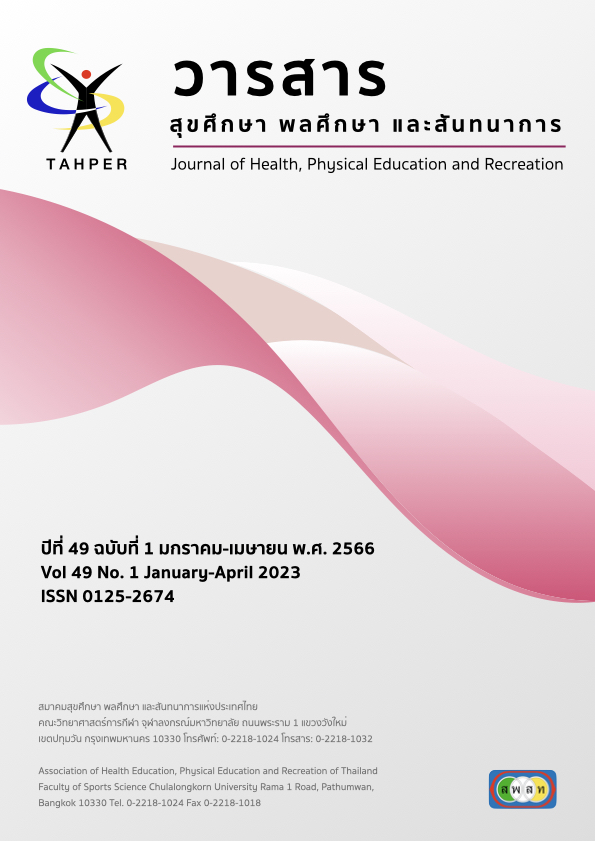Motor Educability of Grade 1-3 Students at Huasai (Reunprachaban) School Nakhon Si Thammarat Province
Main Article Content
Abstract
The purposes of this research were: 1) to study and to compare motor educability of male and female students among Prathom Suksa 1, 2 and 3, and 2) to compare motor educability between male and female students of Prathom Suksa 1, 2 and 3 of the first semester, 2019, Huasai (Reunprachaban) School, Nakhon Si Thammarat Province. The researcher selected Iowa-Brace Test for measuring motor educability. The test consists of 21 items, and the reliability of the Iowa-Brace test was 0.89 in a good level. The population comprised of 155 grade 1 students, 73 boys and 82 girls, 168 grade 2 students, 79 boys and 89 girls, and 155 grade 3 students, 79 boys and 76 girls of Huasai (Reunprachaban) School, Nakhon Si Thammarat Province. The One-Way Analysis of Variance, and LSD methods used to analyze the data.
The results were as follows:
- The motor educability scores of Prathom Suksa 3 male students were significantly better than those of Prathom Suksa 1 and Prathom Suksa 2 students at the .05 level.
- The motor educability scores of Prathom Suksa 2 male students were significantly better than those of Prathom Suksa 1 students at the .05 level.
- The motor educability scores of Prathom Suksa 3 female students were significantly better than those of Prathom Suksa 1 and Prathom Suksa 2 students at the .05 level.
- The motor educability scores of Prathom Suksa 2 female students were significantly better than those of Prathom Suksa 1 students at the .05 level.
- The motor educability scores of Prathom Suksa 1 male students were significantly better than those of Prathom Suksa 1 female students at the .05 level.
- The motor educability scores between male and female of Prathom Suksa 2 students were not significantly different at the .05 level.
- The motor educability scores between male and female of Prathom Suksa 3 students were not significantly different at the .05 level.
Article Details

This work is licensed under a Creative Commons Attribution-NonCommercial-NoDerivatives 4.0 International License.
Critical thinking in journals is the right of the author. The Association of Health Education, Physical Education and Recreation of Thailand is not always required, to create diversity in ideas and creativity.
ความคิด ข้อวิพากษ์ในวารสารเป้นสิทธิของผู้เขียน สมาคมสุขศึกษา พลศึกษา และสันทนาการแห่งประเทศไทยไม่จำเป็นต้องเห็นชอบด้วยเสมอไป เพื่อให้เกิดความหลากหลายในความคิดและความสร้างสรรค์
References
กระทรวงศึกษาธิการ. (2552). หลักสูตรแกนกลางการศึกษาขั้นพื้นฐาน พุทธศักราช 2551. กรุงเทพฯ: ชุมนุมสหกรณ์การเกษตรแห่งประเทศไทย.
กรรวี บุญชัย. (2555). การวัดเพื่อการประเมินผลทางพลศึกษา. กรุงเทพฯ: ภาควิชาพลศึกษา คณะศึกษาศาสตร์ มหาวิทยาลัยเกษตรศาสตร์.
กรรวี บุญชัย. (2560). เอกสารประกอบการเรียนวิชา กศ 0146012 สถิติประยุกต์ทางการศึกษา. กระบี่: สาขาวิชาพลศึกษา คณะศึกษาศาสตร์ สถาบันการพลศึกษา วิทยาเขตกระบี่
กรรวี บุญชัย. (2562). เอกสารประกอบการเรียนวิชาการวัดและประเมินผลทางพลศึกษาขั้นสูง (01172533). กรุงเทพฯ: ภาควิชาพลศึกษา คณะศึกษาศาสตร์ มหาวิทยาลัยเกษตรศาสตร์.
คณะกรรมการการศึกษาแห่งชาติ. (2546). พระราชบัญญัติการศึกษาแห่งชาติ พ.ศ.2542 และที่แก้ไข (ฉบับที่ 2) พ.ศ.2545. กรุงเทพฯ: สำนักนายกรัฐมนตรี.
จิรกรณ์ ศิริประเสริฐ. (2543). ทักษะและเทคนิคการสอนพลศึกษาในระดับประถมศึกษา. กรุงเทพฯ: จุฬาลงกรณ์มหาวิทยาลัย.
ถนอมวงศ์ กฤษณ์เพ็ชร์. (2554). สร้างเด็กไทยให้เต็มศักยภาพด้วยการออกกำลังกาย (พิมพ์ครั้งที่ 2). กรุงเทพฯ: จุฬาลงกรณ์มหาวิทยาลัย.
วิริยา บุญชัย. (2529). การทดสอบและการวัดผลทางพลศึกษา. กรุงเทพฯ: ไทยวัฒนาพานิช.
สุริยัน สุวรรณกาล. (2560). การใช้กิจกรรมทางกายเพื่อพัฒนาความสามารถในการเรียนรู้ทางกายสำหรับนักเรียนประถมศึกษาปีที่ 3 (วิทยานิพนธ์ศิลปศาสตรดุษฎีบัณฑิต). มหาวิทยาลัยเกษตรศาสตร์, กรุงเทพฯ.
Mathews, D. K. (1978). Measurement in physical education (5th ed.) Philadelphia, PA: W. B. Saunders.


